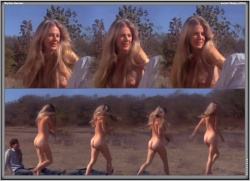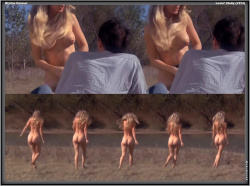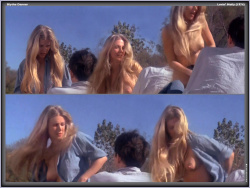The .gif is here
Sample below:
Blythe Danner is Gwyneth Paltrow’s mother, and a respected actress in her own right. Like Paltrow, Blythe did some nude scenes in her younger days, showing off a figure rather curvier than her daughter’s.
Her most famous nude scenes came in a well known 1974 film called Lovin’ Molly, which was written by, directed by, and starred some of filmdom’s most respected figures, as well as some promising newcomers. Larry McMurtry wrote the source novel; Sydney Lumet directed; and Ms. Danner’s castmates included Beau Bridges, Anthony Perkins, and Susan Sarandon.
Given the talent involved, Lovin Molly’ should have been a slam dunk for an excellent movie. Lumet was more or less in the prime of his career, as Lovin’ Molly was made between Serpico and Dog Day Afternoon. McMurtry was still basking in the glow of the encomiums heaped upon The Last Picture Show.
It wasn’t a great movie, although it has some very nice moments. According to IMDb, screenwriter Steven Friedman never wrote another script before or after this one, and McMurtry’s sprawling story, spread out over 40 years in the lives of two men who loved the same woman and each other, proved to be difficult for the inexperienced screenwriter to adapt into an economical screenplay. McMurtry’s source novel, “Leaving Cheyenne,” had the advantage of an unlimited expanse of printed pages to develop sub-plots and subtext in a leisurely, thoughtful way, as well as to create some beautiful homespun prose which often moseyed into the territory of simple country poetry. The screenwriter just didn’t seem to have the heart to cut out any plot points, so the individual scenes seem rushed and excessively compacted, and the transitions between scenes seem to be dominated by abrupt jumps forward in time. Unfortunately, chronicling the minutiae of events over four decades didn’t leave enough time for the proper development of motivation and character, to such an extent that the movie ends without us ever really knowing much about one of the two men who loved Molly, the one played by Beau Bridges, although we do love him at the end as a colorful and generous-spirited old geezer.
Lovin’ Molly plays out like one of those Doug Sirk soap opera films from the 50s rather than like a character-oriented 70s piece. If it had been my decision, I would have found a way to minimize or even eliminate the last two acts, particularly given the silly make-up used to age the characters.
The script fails in other ways. The portrayal of Texas rurals seems like the kind of “noble savage” idealization that would be created by someone who had never left Boston. Furthermore, the author chose to replicate the feel of McMurtry’s language by simply having it read in narrative voice-over, with each of the three acts narrated by one of the three main characters, following the structure of the book down to the last detail.
The script problems were complicated by the odd casting of ol’ Norman Bates as a sane heterosexual from the rural Texas Panhandle. Perkins seems like a disturbed city boy from New England who is recruited to play a country boy in the school play because the drama teacher thinks it will help him cure his introversion. His love scenes with Blythe Danner were, to understate the case kindly, lacking in electricity. He was supposed to be someone who had trouble expressing affection, but he took it to pathological extremes.
SIDEBAR:
As I recall, Mr. Perkins was not really inclined to appreciate feminine pulchritude when he was a young man, but by the time this was lensed, he had decided to try sex with women. He was about 40 when he had his first heterosexual experience, and seemed to like it enough to marry a woman two years later. He married the younger sister of Marisa Berenson, fathered two sons by her, and remained with her for some two decades, until his death. About a decade after Perkins died, his widow died in the 9-11 attacks. She was aboard AA flight 11, which crashed into the North Tower.
I still like Lovin’ Molly in some ways. It can get inside you and melt your heart in its best moments. It’s easy to understand why the boys loved Molly, as played with feisty unconventionality by beautiful Blythe Danner, who had some talent to match her looks.
But the damned thing just isn’t as good as it should have been.
It’s been more than thirty years since this film was made, and it’s almost completely forgotten, so I’d love to see somebody else try their hand at McMurtry’s “Leaving Cheyenne.” I still think there’s probably a great movie in there somewhere.
Anyway …
Brainscan created some collages of Blythe Danner’s nudity in Lovin’ Molly



That is all well and good, but is actually only my usual long-winded preamble to today’s topic, which is another film in which Blythe Danner got naked, a 1972 effort called To Kill a Clown.
Although there are monumental exceptions like The Godfather, many films from the hippie era (1967-1974) don’t hold up well. They often feature cartoonish portrayals of military types and conservative authority figures, as contrasted to mawkishly hagiographic portraits of hippies and other counter-cultural types.
Movies don’t exist apart from society, of course, but tend to reflect it. That era was a time when American society contained divisions as deep as today’s, or even as deep as those of Lincoln’s time. The Vietnam War occupies a unique place in our modern cultural history, in that society’s condemnation of the war extended to those who fought in it. The activists who opposed America’s involvement in other unpopular wars like Iraq or Afghanistan were still able to say “Thank you for your service” to the brave soldiers who placed their lives on the line to fulfill the assignments that their country gave them. Not so with Vietnam. It was bad enough that those veterans came home from their tours of duty with PTSD, but they also faced hostility, indifference and employment difficulties. The ultimate irony is that, unlike soldiers in our contemporary army, most Vietnam vets did not choose military service. They were drafted. The obloquy hurled against them by civilian society was a demonstration of how people in a divided society demonize their ideological opposites, even in the face of all logic.
Many career soldiers and ex-soldiers in the films of that era were portrayed as callous martinets, brainless rednecks and violent fascists. In this film, the bitter one-dimensional ex-soldier was Evil Alan Alda, a bitter and twisted ex-major with irreparable combat injuries who basically uses his vicious dogs to kidnap a hippie couple and turn them into his personal troops. “Put on a shirt, and button it. Button every button.” As you can infer from that description, not all of Evil Hawkeye’s injuries were the physical type.
Blythe Danner plays the female member of the hippie couple, and at one point she becomes so desperate to escape Evil Hawkeye that she gets naked and tries to break down his angry veneer by seducing him tenderly. He spots this as a ruse which includes no genuine affection for him, so he chases her out of his home, angrily insisting she comply with an immediacy that denies her the chance to get dressed. It is in the scene of seduction and subsequent humiliation that we in the audience got to look at Blythe Danner’s naked body on film for the first time.
(The YouTube link jumps directly to the nude scene.)
Unfortunately for fans of Alan Alda and Blythe Danner, this film has never been available in any better quality than what you see in that YouTube version, which has probably been remastered from a VHS source.
It’s not much of a movie. The characters are one-dimensional and their actions are illogical, even within their own defined universe. As poor as the script is, the direction by George Bloomfield is even worse. The pacing is slow, and the ending isn’t really an ending at all. It is so abrupt and unsatisfying that you wonder if maybe they just ran out of film.
It’s frankly absurd that this film is rated 5.4 at IMDb while Lovin’ Molly is at 5.5. They are not at all comparable in quality. While Molly is not a cinema classic, it has some merit and should probably be in the 6s, while this film should be in the 4s or lower. Oh, I’m being euphemistic. To be brutally frank, this film should never have been made at all.
But you don’t have to take my word for it. That YouTube link above is the entire film, if you’re interested enough to watch it.
Jenni Neidhart is the daughter of the old-time wrestling personality, Jim “The Anvil” Neidhart, and the granddaughter (through her mother) of an even older-time wrestling personality, Stu Hart.
Jenni isn’t in the wrestling game, but has established herself as an internet personality and gourmet chef (or so I read).
